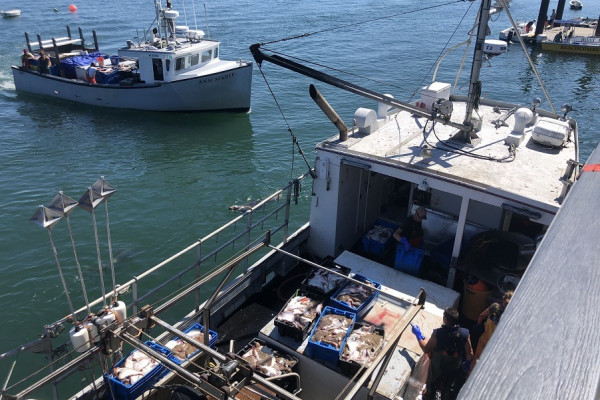
“Port by Port: Profiles and Analysis of the Massachusetts Commercial Fishery” bears down on an industry often overlooked when people think about the state’s economy.
By Seth Rolbein
Everyone interested in commercial fishing’s role and impact for Massachusetts, particularly if working through solid numbers is a fun wonky exercise, will find a new report released by the Massachusetts Division of Marine Fisheries a satisfying, enlightening document.
“Port by Port: Profiles and Analysis of the Massachusetts Commercial Fishery” link bears down on an industry often overlooked when people think about the state’s economy. Its great strength is a foundation of gritty, port-by-port info; actual landings town by town, species by species, as well as clear notes on challenges and trends seen by harbormasters and commercial fishermen.
The report also goes big-picture, suggesting ways the public sector can make sure commercial fisheries remain viable and vital.
For harbormasters and fishermen, this is great stuff to take into town halls and town meetings to support investment in healthy ports.
For town officials, this is great evidence to take to the county and state to buttress funding requests for maritime infrastructure.
And for state officials, this is great credibility to bring into federal conversations, proof positive that major investments on the waterfront spur broad and deep economic returns.
The report is the result of more than a year’s work and collaboration among the Division of Marine Fisheries, the Urban Harbors Institute at UMass Boston, and the Cape Cod Commercial Fishermen’s Alliance, with support from the Massachusetts Seaport Economic Council. Landing data was analyzed, dissected, and collated. Surveys were sent to every harbormaster in the state, as well as a cross-section of commercial fishermen. Fact-checking followed, assumptions pressure tested, follow-up phone calls and data crunching ensued. Best ways to format, illustrate, and distribute were debated.
If there was any frustration among the creators (perhaps to be shared by the general public), it was that the data is from 2018, the latest full set available. Also, in some smaller ports specific landings could not be listed because state rules prohibit showing hard numbers when it would reveal financials of one or two private businesses. DMF already is thinking about how to update, perhaps with a new appendix as more recent data comes forward, and how to protect confidentiality while informing the public.
Big picture, the size and strength of the industry becomes apparent. There were 734 million pounds of fish and shellfish landed in Massachusetts in 2018, which translates into an “ex-vessel” value, meaning money paid directly to fishermen and harvesters, of $647 million. That number multiplies as it moves into the economy of wholesale, retail, restaurants, and export. That also translates into 128,000 jobs directly connected to commercial fishing.
From the Cape’s perspective, both Chatham and Barnstable rank in the top five Massachusetts towns for landing values, with Wellfleet, Provincetown, and Sandwich joining in the top ten. That said, New Bedford alone, driven by its powerhouse scallop fleet accounting for most of the port’s $431 million in landings, dwarfs the rest of the state combined.
A general decline in finfish landings also is evident: the top five most valuable state landings by species all arrived in shells: scallop, lobster, oysters, surf clams, and – probably a surprise to many – Jonah crab.
The hard numbers, along with informed anecdotal reports from people working on the waterfront, lead to pragmatic recommendations for public officials. They include ways to improve commercial access at ports, avoid conflict with recreational boaters, standardize fees, all making a strong case that investment in support like ice machines, lifts, parking, and offloading capacity are smart and create long-term return.
Of all problems raised, dredging challenges and access to open water were most prevalent. An analogy to our highways emerged: Public work to keep roads open and safe is an undebated key to economic activity and access. Keeping harbor channels open should be seen in the same terms. Suggestions on how to do that ranged from taking a hard look at time-of-year restrictions to more public dredges to the idea of a state bond bill, similar to bond bills for education, transportation, and the environment, that would focus on ports and harbors.
But probably the hard numbers, crunched town by town and presented in an accessible, creative format, will prove most useful to most people. And now that a foundation document has been created, building off its structure will make future reporting easier and quicker.
Sometimes big state reports, created with the best of intentions, wind up gathering dust on a shelf – or these days, sit unopened in a computer folder. That does not seem to be the fate of this one.
